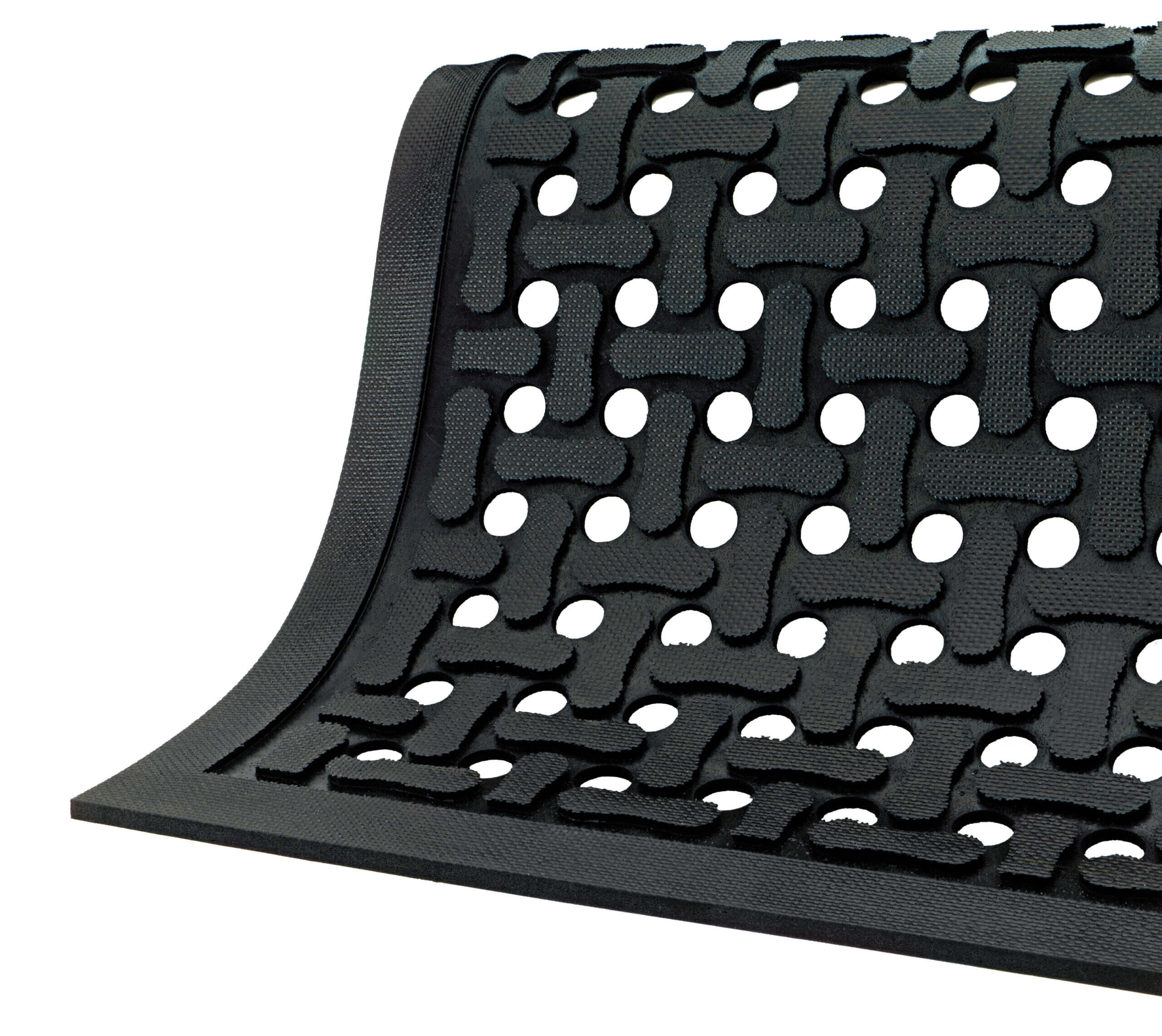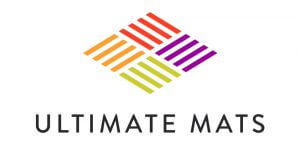
Rubber Floor Mats: What Are They and How do They Work?
New to the world of commercial matting? We’ve got you covered. Ultimate Mats has been selling high-end, rubber floor mats since 2005. As such, we know which matting manufacturers use the best materials to ensure their mats are durable, effective, and always aesthetically pleasing. Whatever your reason for needing a rubber mat, you’ve come to the right place.
Rubber floor mats come in a variety of shapes and sizes and cover a plethora of needs. They can be used commercially and are also available for at-home use. Commercially, our clients typically prefer rubber floor mats to any other kind of entryway floor mat because of their durability and performance. A rubber floor mat can be constructed in a way such that it practically eliminates dirt and water from entering and exiting foot traffic. This can be a huge time-saver if you find yourself and your employees constantly mopping, vacuuming, and sweeping your showroom floor.
Additionally, rubberized anti-slip floor mats provide a great safety barrier for you, your employees, and your customers. Placing non-slip rubber floor mats in areas of high traffic or potential water hazards (such as near sinks and water fountains) reduces the risk for slip, skid, and fall accidents since they are totally waterproof and slip-resistant. Ask any injury attorney and they will tell you that slip and fall accidents are very common, and one of the best ways to prevent these accidents is by placing rubber floor mats and stall mats inside and outside of every door and never every water hazard area.
Lastly, rubber floor mats present an excellent marketing opportunity for the savvy business owner. You already know that any place is a great place to advertise your brand, and using logo rubber door mats and entrance mats to advertise your brand creates brand familiarity with your patrons and greets them in style. Screen-printed rubber mattings are able to display your logo, company name, and/or slogan so that your patrons are greeted with the brand you’ve worked so hard to create as soon as they enter onto your premises.
If you’re ready to order a set of rubber floor mats, we’re here to help. We’ve got your ultimate guide to rubber floor mats including how they work, what types are available, and which will best suit your needs.
How Do Rubber Floor Mats Work?
To understand fully how rubber floor mats work, we first need to look at what rubber floor mats are up against.
Rubber floor mats are most often used to trap dirt, water, and other sediments from the shoes of foot traffic entering upon a premise. They are also used for trapping water and spills near areas like sinks, water fountains, and coffee bars, effectively eliminating a slippery hazard to people who would pass by or frequent these areas.
Because of their intended use, their design must be such that they can actually trap the unwanted water and sediment without looking dirty, full, or unsightly. Companies use rubber floor mats because they not only accomplish this job, but they also do so in style.
Here are some of the key features that make rubber floor mats so effective:
Mat face. The portion of the mat that people step upon is referred to as the mat face. The face of the mat has to be created from a material that is effective at wiping and scraping the foot traffic that passes over it. A high-quality rubber floor mat will have a mat face that both scrapes and wipes shoes as they pass over the mat. Rubber floor mats can achieve this by creating a certain pattern in the textile. Whether the material is constructed from 100% post-consumer drink bottles or another synthetic material, the patterned surface should be one that effectively grips dirt and sediment from the shoes of foot traffic and brings it to the bottom surface of the mat. Some popular patterns for rubber floor mat faces are diamond, waffle-weave, and raised square.
Border dam. A great rubber mat will have a border dam that does not allow water to move from the inner parts of the mat where it is collected from shoes and umbrellas onto the surrounding floor area. This design is critical for mats that are located in entryways and outdoors. If a rubber floor mat does not have a border dam, the water it collects from rain, sleet, snow, or spills will simply bleed out onto the floor surrounding the mat creating a hazard. In addition to the border dam, the rubber floor mat must also have a depth that allows for standing water to be held until the mat naturally dries. It is important that the mat be able to dry on its own, as any rubber floor mat that does not dry is subject to developing mold and mildew.
Heavy-duty rubber backing. Lastly, a rubber floor mat is truly only as effective as its backing. If you have a great quality mat face with a terrific border dam, it is of little use if the rubber floor mat cannot stay properly placed. Rubber floor mats are made with sub-surface nubs that allow them to grip the floor’s surface and stay put, even under extreme and wet conditions.
It’s important to note that there are specialized backings for different types of flooring. Typically, you will notice two specific types of backings: one for carpeted or “high-pile” surfaces, and one for smooth floorings such as concrete, tile, and wood. Be certain you purchase the correct backing for the floor where your mat will be located, taking into consideration that a backing created to grip a carpeted surface could potentially damage a smooth surface.
What Types of Rubber Floor Mats Are Available?
There are numerous styles of rubber floor mats available that can do the tough work of removing dirt and water from your clientele before they enter your store space. Selecting the appropriate ones that work best in your space is a matter of determining size, foot traffic, and aesthetics:
Size. The size rubber floor mat you will need depends on two things: the size of your space, and the amount of foot traffic the space will see. To determine the appropriate size rubber floor mat you need, measure the space that is hosting the mat. For instance, if you want to place a mat inside your front entrance, measure the width of the front entrance. Your rubber floor mat should be at least 80% of the width of the entrance. The same rule applies to other areas. If you were purchasing a rug for a coffee bar, you would want the rug to cover 80% of the total width of the coffee bar area.
It is completely acceptable to have a mat that measures the entire length of your space but keep in mind accounting for things like door clearance, cabinetry that must open and close, etc.
When determining rubber floor mat length, you want to ensure that the mat allows for a patron to step on it with each foot. For an entryway mat, the length should be the distance it would take an average person to stride twice (once with each foot) over the mat. There are also rubber flooring mats available that interlock above the subfloor — providing you with a great DIY rubber tile option so that you can create your own custom fit area rug that’s great for areas like home gyms or even for outdoor use.
Foot traffic. The type of rubber floor mat you need will also be determined by the amount of foot traffic it will accommodate. For low trafficked areas, a thinner, or more decorative mat could be considered, however for heavily trafficked areas, you’ll want to select a mat of greater thickness with a greater ability to remove more dirt and water.
If you are unsure of the amount of foot traffic you have, it may be a good idea to install a counting device to figure out that number. Having a better idea of how many patrons you host per day can make the mat buying decision much easier. You can expend a lot of money on a high-quality mat that simply is not designed to accommodate the amount of foot traffic you have, leading to frustration and the necessity of purchasing another product.
There are also anti-fatigue mats or comfort mats made out of a rubber material that help with shock absorption and reduce strain on your limbs from standing for a long time.
Aesthetics. As aforementioned, rubber floor mats are workhorses, but they don’t have to be eyesores to your home decor. There are some extremely beautiful rubber floor mats available today to ensure that the interior design you have custom created for your space remains unaltered by your matting system. While most rubber floor mats will be available in neutral, low-profile designs and colors like black, gray, and tan, you can also experiment with mats that bring forth a pop of vibrant color like teals, oranges, and reds.
Additionally, there is always the option to screen print your rubber floor mat with your company name and logo. There’s no better way to market your brand than by turning your rubber floor mats into valuable advertising space.
Rubber floor mats are a necessity for practically every brick and mortar business that exists. Capable of removing dirt and excess moisture from foot traffic, rubber floor mats are effective at keeping your store and business spaces clean and free from hazards. Purchasing rubber floor mats that are attractive and/or bear your brand name and logo is a smart and aesthetically appealing way to add to your interior design and style while keeping yourself, your employees, and your patrons safe.
Sources:
https://www.rosenbauminjuryfirm.com/articles/the-right-door-entry-mats-reduce-the-risk-of-slip-and-fall-accidents/ https://www.cleanlink.com/hs/article/Choosing-The-Right-Backing-For-Matting–20128
